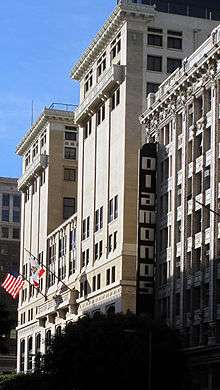Los Angeles Athletic Club
Los Angeles Athletic Club (LAAC) is a privately owned athletic club and social club in Los Angeles, California, US. Established in 1880, the club is today best known for its John R. Wooden Award presented to the outstanding men's and women's college basketball player of each year.
 LAAC Building, on 7th Street in Downtown Los Angeles | |
| Genre | athletic club social club |
|---|---|
| Founded | September 8, 1880 |
| Headquarters | 431 West Seventh Street Los Angeles, CA 90014 |
| Website | laac |
| Designated | September 16, 1970 |
History
Establishment
The Los Angeles Athletic Club (LAAC) was founded on September 8, 1880. By the end of its first month of existence the fledgling club counted 60 enlisted members and was able to rent its first facility, two halls located in Stearns Hall on Los Angeles Street in downtown Los Angeles.[1] A 19th Century history indicates that the club had the dual purposes of "providing its members with the means of physical development" along with "the advantages of a gentlemen's club.[2]

The club relocated for the first time in 1881, moving to more commodious accommodations in the Downey block, before moving again a few years later to a still-larger home in the Stowell Building.[2] Membership in this latter location soon topped the 400 mark, prompting the construction of the club's own permanent building, a four-story structure with a cavernous gymnasium located on an enlarged third floor.[2]
The club provided a venue for gymnastics, athletic training, and team sports, including organization of a civic football team which played the inaugural intercity match with San Francisco in January 1892.[3] During its first two decades of existence the club also established an outdoors athletic park, which included a running track and path for bicycling, a baseball diamond, tennis courts, and facilities for croquet.[4] It also provided rooms designed for socialization, including an expansive reading room,[4] as well as designated areas for billiards and cards.[5]
1912 relocation
In 1912 it moved into its own new Los Angeles Athletic Club Building at 431 West Seventh Street in Downtown Los Angeles. The twelve-story Beaux-Arts style clubhouse was designed for the LAAC by John Parkinson and George Bergstrom, and is a Los Angeles Historic-Cultural Monument. The building was notable for being the first in Southern California to have an interior swimming pool built on an upper floor.
Due to its position in the growth and development of Los Angeles, the LAAC had significant success during its first 60 years, with membership reflecting its position in Los Angeles society and early Hollywood culture. During its heyday, the LAAC founded a number of other institutions, including the California Yacht Club (1922) and Riviera Country Club (1926). They are now separate entities.
The club faced significant financial burdens due to World War II and the subsequent growth of suburbs.
Athletes from the LAAC have earned numerous medals in the Summer Olympics, with a particularly high number during the 1932 Los Angeles Olympiad. The total Olympic medal tally for the LAAC is 97 medals, including 47 gold.[6]
Notable members
- Arthur Alber, Los Angeles City Council member, 1927–29
- L. Frank Baum
- Charlie Chaplin
- Reginaldo Francisco del Valle
California State Senator who was instrumental in forming UCLA. California Water Commissioner responsible for bringing water from the Sierras to the city. His wife Helen co-owned the Los Angeles Times. Del Valle was an Attorney.
- George P. Cronk, Los Angeles City Council member, 1945–52
- Edward L. Doheny
- Mayor Fred Eaton
- Caroline Estes Smith
- Douglas Fairbanks Jr.
- Robert Frederick Foster
- Louis F. Gottschalk
- A. E. Henning, Los Angeles City Council member, 1929–33
- Henry Huntington
- Duke Kahanamoku, member of LAAC swimming and water polo teams, also club's lifeguard
- Georgia Thatcher Kemp (November 22, 1868 – March 9, 1945), a native of Placerville, California, daughter of William Wallace and Sarah E. Thatcher. Married to Attorney John William Kemp. Very active in club and civic affairs. Member: Los Angeles Woman's Athletic Club, Friday Morning Club. Home: 2115 So. Hobart Blvd., Los Angeles, California. Buried at Forest Lawn Memorial Park (Glendale).[7]
- Harold Lloyd
- Parry O'Brien
- Colonel Harrison Otis
- Mary Pickford
- William Desmond Taylor, movie director[8]
- Moses Sherman
- Rudolph Valentino
- Johnny Weissmuller
- Senator Stephen White
- Esther Williams
See also
- List of American gentlemen's clubs
- List of Los Angeles Historic-Cultural Monuments in Downtown Los Angeles
Footnotes
- "Los Angeles Athletic Club Leases Gymnasium," Los Angeles Herald, Sept. 26, 1880, pg. 3.
- Charles F. Lummis (ed.), "Los Angeles Athletic Club," The Land of Sunshine [Los Angeles], vol. 5, no. 3 (Aug. 1896). pg. 134.
- "World of Sport: The First Great Ball Game of the Year," Los Angeles Herald, Jan. 1, 1892, pg. 5.
- Lummis (ed.), "Los Angeles Athletic Club," pg. 135.
- Lummis (ed.), "Los Angeles Athletic Club," pg. 136.
- "LAAC History: 1951-1969," Los Angeles Athletic Club web site, www.laac.com/
- Binheim, Max; Elvin, Charles A (1928). Women of the West; a series of biographical sketches of living eminent women in the eleven western states of the United States of America. p. 58. Retrieved 8 August 2017.

Further reading
- Sandi Hemmerlein, "The Los Angeles Athletic Club: The Story of an LA Icon," Discover Los Angeles, Aug. 3, 2015.
- Charles F. Lummis (ed.), "Los Angeles Athletic Club," The Land of Sunshine [Los Angeles], vol. 5, no. 3 (Aug. 1896). pp. 134–138.
- Henry Winfred Splitter, "Los Angeles Recreation, 1846-1900: Part 1," Historical Society of Southern California Quarterly, vol. 43, no. 1 (March 1961), pp. 35–68. In JSTOR
- Henry Winfred Splitter, "Los Angeles Recreation, 1846-1900: Part 2," Historical Society of Southern California Quarterly, vol. 43, No. 2 (June 1961), pp. 166–199. In JSTOR